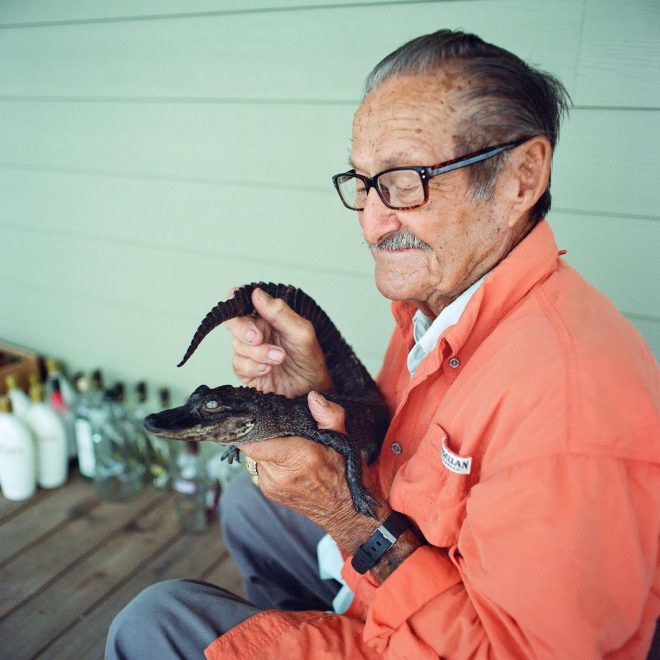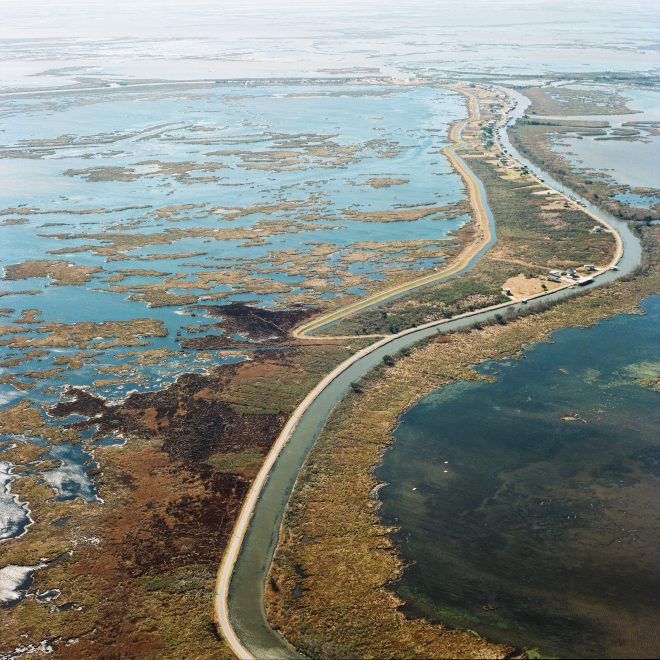Taking Notice: JT Blatty at Martine Chaisson Gallery
Dillon Raborn considers how JT Blatty’s photographs, currently on view at Martine Chaisson Gallery, might inspire viewers to take action against climate change.

JT Blatty, Doogie and the Gator, 2015. Archival pigment print. Courtesy the artist and Martine Chaisson Gallery, New Orleans.
The wetlands are dying. This fact has been hammered home by what feels like hundreds of awareness campaigns by state agencies and advocacy groups to the point that the environmental reality has nearly become hackneyed to the ears of listeners. Most Louisianans do not live on the bayou, so numbness to reminders of our circumstances begins to set in. For this reason, JT Blatty’s approach in her Fish Town series, now on view at Martine Chaisson Gallery, is important because it humanizes the issue—something easily done, considering the communities of Louisianans disappearing with the land itself.
“Fish Town” is accompanied by a printed publication of the same title containing the photographs in the show as well as documented oral histories of coastal communities sustained by the fishing industry. In the exhibition, generational legacies are most emotionally felt in one of its smaller photographs, Doogie and the Gator, 2015, a portrait of an elderly man whose labor-worn hands gently cradle an infant alligator, a blurred collection of whiskey and rum bottles set behind them. It’s a simple, but effective, image. However, Doogie is one of only a handful of photographs in the exhibition featuring figures.

JT Blatty, Delacroix, 2014. Archival pigment print. Courtesy the artist and Martine Chaisson Gallery, New Orleans.
Blatty embeds human interest in a documentary framework mostly by her use of the imagerial index, an idea first formulated by semiotician Charles S. Peirce to describe presence through absence. Whereas Peirce cited a bullet hole as an indicator of the former presence of a bullet, Blatty ups the scale significantly in Delacroix, 2014, an aerial shot of the unincorporated fishing town in St. Bernard Parish. Barely a vehicle is seen on the road peppered with seemingly inactive buildings parallel the boatless river. Counter to the visual clarity of Delacroix is the haunting, otherworldly lighting and color scheme of Shell Beach Night, 2014, another humanless composition of a humble fishing vessel dragged onto a grassy shore, coated orange by the photographer’s lighting fixture. In the evening sky, a giant oak silhouette is cast against what looks to be an extraordinarily bright city glow, the distant bustling activity in contrast to the shore upon which viewers are placed alone.
“Fish Town” is a simple but successful reminder that however important an issue, humanizing it can hoist a sense of urgency upon what may otherwise seem like someone else’s problem. To humanize is to make it our problem and frame it with a responsibility to acknowledge it or, hopefully, act on it.
Editor's Note
JT Blatty’s “Fish Town” is on view through October 13, 2018, at Martine Chaisson Gallery (727 Camp Street) in New Orleans.



